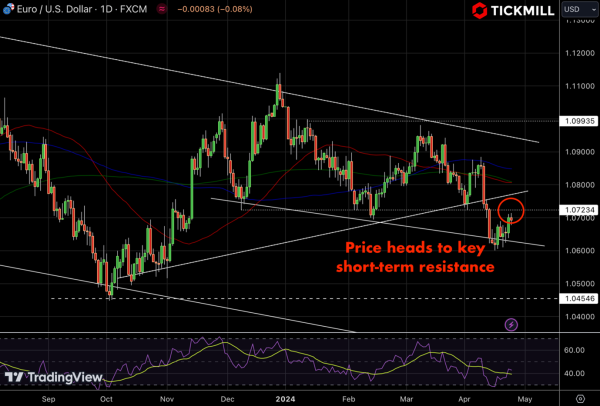Durable Goods Data Dampens Dollar Recovery
The US Dollar found itself on a rollercoaster ride today as its attempt at a recovery hit a speed bump post-US Durable Goods release. Despite the figures surpassing expectations, the downward revisions gave investors pause, leading to a slight softening in the USD and, subsequently, the US Dollar Index (DXY). This setback puts the brakes on any aspirations of the DXY climbing back above the 106.00 mark for the day. EURUSD faces a test of the key short-term resistance level, which, upon breakout, will unlock the path higher:

Yesterday, the greenback took a hit following S&P Global's unexpected report revealing lackluster preliminary US PMI numbers for April. The Manufacturing PMI slipped below the critical 50.0 threshold, indicating a contraction, while the Services PMI saw a sharp decline to 50.9.
Looking ahead, all eyes are on the US Gross Domestic Product (GDP) report due on Thursday. Additionally, investors will keep a keen eye on the weekly US Jobless numbers, especially given the slew of layoffs announced by several companies this earnings quarter.
Equities are experiencing a slight ease after the Nasdaq's earlier surge of 1% spurred by the Durable Goods release. Meanwhile, Europe is witnessing gains taper off towards the close, with some profit-taking activities dampening the overall sentiment.
According to federal funds rate futures, June is likely to see no change in the monetary policy rate by the Federal Reserve, with an overwhelming 85% probability. However, September holds a 47% chance of a rate cut compared to a 32% probability of remaining unchanged.
The recent rally of the US Dollar Index can be largely attributed to the robust US economy, which consistently churns out positive economic indicators. While Tuesday's PMI figures missed estimates for the first time since last year, investors are viewing it as a blip rather than a significant setback. Nevertheless, market participants are cautious and await further confirmation from this week's data points, and possibly even next week, before reassessing the probability of a rate cut in June.
On the other side of the pond, the Pound Sterling retreated from 1.2450 against the US Dollar during Wednesday's early American session, following a strong rebound from a five-month low near 1.2300 earlier in the week. The GBP/USD pair dipped marginally as the US Dollar gained traction after Tuesday's correction. The British currency witnessed a sharp upward surge following the release of a robust United Kingdom preliminary PMI report for April by S&P Global. The Services PMI soared to 54.9 from the previous reading of 53.1, surpassing forecasts of a slight decline to 53.0.
Despite the mixed bag, the uptick in new business volumes across the private sector suggests a positive outlook for consumer spending, potentially fueling inflationary pressures. This scenario could provide the Bank of England (BoE) with leeway to postpone interest-rate cuts, painting a favorable picture for the Pound Sterling's future trajectory.